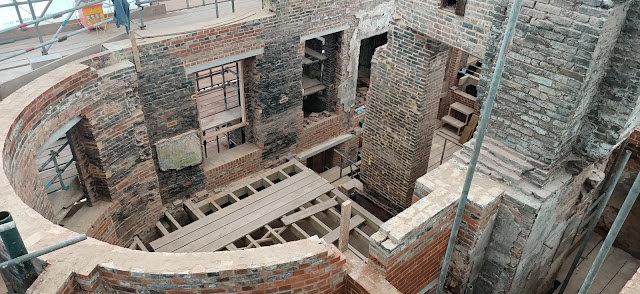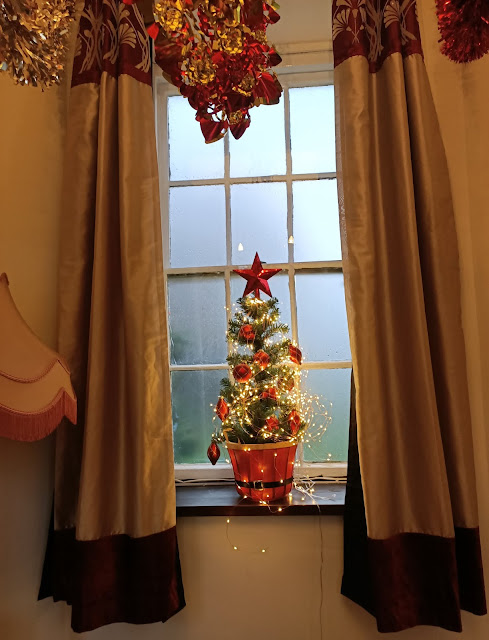The Ship of Theseus, and the Wreck of Betley Court
Before the recent open days, when we showed visitors around the shell of Betley Court, Mark our architect played host to three students. It was part of a scheme to get architecture students involved in the realm of restoring, rebuilding and where appropriate, repurposing heritage buildings. Betley Court became their case study, as an example of a building where decisions need to be taken as to what the nature and degree of that restoration should be.
 |
| Mark the architect, on a site visit with the students |
Mark posed the question to the three students about one of the rooms worst hit by the fire; the Nash Room. John Nash, famous Georgian architect was engaged in 1808 by Sir Thomas Fletcher to remodel a dining room into a drawing room with a bow containing three pairs of curved French fully glazed doors. A vaulted ceiling and elaborate coving were also installed. In the intervening years, Nash’s fire place was repositioned, and by the time the Brown family bought Betley Court, large portions of the ceiling and coving had fallen away. They engaged the artist Philip Knapper to make repairs to the coving that so closely matched the original, they needed to be pointed out to you.
 |
| The Nash Room, as restored by Freda and Godfrey Brown c.1980s |
Following the fire, all that was left of the Nash Room was
part of the later chimney breast, and at the other end of the room, Nash’s
original fireplace (which had been hidden behind plaster at some point). Mark
asked the students how far would they go to restore this room. One student felt
reinstating the Nash room should be to reimagine how it was when Nash created
it. Another disagreed, and thought it problematic slavishly trying to recreate
a room when we had no real idea of how it looked originally. How ‘authentic’
would a facsimile Nash room be? The third advocated somewhere in between, with
a recreation of some elements. There was
a lively discussion and terms like ‘Disney-fycation’ and ‘historically accurate’
were bandied about as the group debated the rights and wrongs of rebuilding.
Nigel had his input too, arguing that as the room had a two-hundred-year-old
history, which ‘authentic’ version do you restore to? If one was restoring
Betley Court as a Red Cross hospital museum, then that very same room might be rebuilt
as a patients’ day room, or consulting room.
Of course, the Nash room was a family sitting room during
the forty years the Brown family used it before the fire; scene of family
Christmases, reunions, parties, baby welcoming and memorial gatherings. Our
family hub. Whatever is decided between planners, architects, heritage people
and the family, that purpose would seem the most important.
There was a similar discussion over the reinstating of the stair case. The staircase was a beauty, hand carved in oak, with individual flowers chiselled into each step. Prof Brown had a theory that it was made by Thomas Swann, because of its similarity to the staircase at Rode Hall.
 |
| The ornately carved staircase at Rode Hall in nearby Cheshire has similarities to the one we lost, in terms of carving. |
Only one spindle and one tread were found in the ashes. Our lasting regret is that we never took any photos of the details of the stairs, so a rebuild would be pure guesswork. And anyway, it is believed the the stair case wasn’t originally made for Betley Court. It was designed for a taller house, and was somehow shoehorned in, necessitating the floors on the first floor of the main house to be raised by a foot or so!
 |
| Prof & Dr Brown at the foot of the old staircase. |
Once again, it was not an 'original' feature. We have diagrams of its predecessor, a typical Georgian staircase, but in a different position. Which version of the past do you rebuild to? It is one of the most intellectually challenging part of the rebuild.
“It’s like the Ship of Theseus, isn’t it, Mum?” piped up our middle child, recalling the ancient story of a ship that was preserved to commemorate a voyage. One by one, decaying parts were replaced as the ship aged, until there was precious little of the original ship left.
 |
| Artist's impression of the Ship of Theseus |
It’s a famous philosophical question posed to students of architecture, engineering and heritage. At what point does it stop being the original object? The woodman’s axe, or its TV equivalent, Trigger’s Broom exemplify the issue. In one of the most iconic scenes in British television comedy, Trigger, the butt of so many ‘Only Fools and Horses’ jokes, proudly reveals that he has used the same brush for the whole of his road sweeping career. “This old broom”, he says “has had 17 new heads and 14 new handles”). Hardly the same broom, then. And yet, still arguably, Trigger’s Broom.
 |
| Trigger and his broom |
The question of
authenticity will be batted back and forth until we arrive at an answer for
Betley Court. For now, I’m just grateful that brick by brick, something
recognisably Betley Court-shaped is coming together behind the scaffold wrap.
All best wishes
Ladybird Su



Comments
Post a Comment